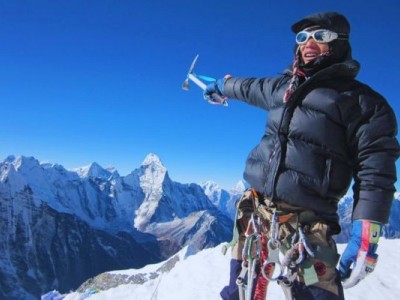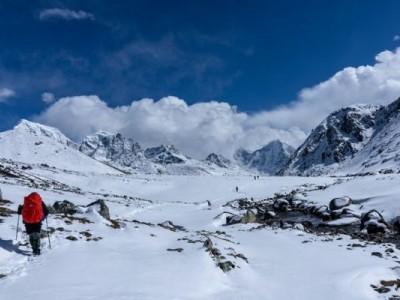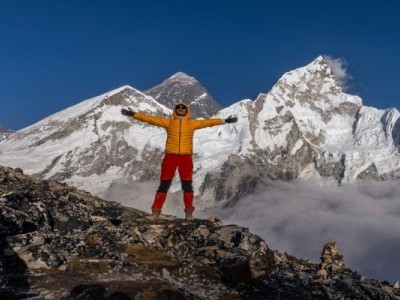Altitude sickness is a serious hurdle in high-altitude trekking or climbing. It can be lethal if not treated seriously. Generally, the sickness occurs while traveling to high altitude places beyond 2500 m without proper acclimatization. The main cause of altitude sickness is the lack of oxygen in the body.
There are many names for High Altitude sickness. People also call it hypobaropathy, Acosta, puna, Acute Mountain Sickness (AMS) and soroche. Regardless of the term, the outcome is the same. People love to travel high altitude places. In fact, these places offer the rewarding scenery of mountains and landscapes.
If you can endure all the hardship, marvelous scenery can be beholden. For example, once you trek to the top of Kalapathar (5545 m); the scenery of the entire Khumbu including Mt. Everest looks spectacular.
Let’s find out more about Altitude sickness. At the end of this blog, I expect all the readers to have at least a general idea to avoid altitude sickness during high-altitude activities.
What are the symptoms of Altitude Sickness?
Symptoms of altitude sickness depend on many variables. Person's age, lung capacity, blood pressure level, weight, etc. It depends upon the type of ascending that he/she does. Time factor plays a vital role too.
For example, a quick ascent to a high altitude from a low altitude for a very short time may not result in altitude sickness.
However, if a person stays for a long period doing unusual physical movements;
altitude sickness can occur.
Here are the general symptoms of altitude sickness:
- Nausea/Vomiting
- Loss of Appetite
- Extreme exhaustion
- Dizziness and Insomnia
- Shortness of Breath
- Limbs and Face Swelling
Proper care must be given to these symptoms. You must not wait any longer once you catch these symptoms. Fluid in the lungs and swelling in the brain may become fatal. If the liquid is filled in the lungs the following symptoms may appear.
- Cough with a pinkish spit
- Fever
- Persisting panting even during the rest
- And the symptoms of the case when your brain swells are:
- Headache
- Fainting
- Vomiting
- Loss in consciousness
- Dizziness and numbness
What are the types of altitude sickness?
There are different stages of altitude sickness. Monge’s disease is a chronic form of mountain sickness. It occurs if you spend extended time at a high altitude. Acute altitude sickness occurs in a short period. Trekkers can experience acute altitude sickness in just about 1-5 days while trekking beyond 8000 ft. from sea level. This acute altitude sickness may lead to severe cases like cerebral edema and high-altitude pulmonary edema.
What are the Causes of altitude sickness?
The major cause of altitude sickness is the rapid ascent to high altitude. Altitude sickness can also occur after spending an extended period of time at a high altitude. The normal air-to-oxygen ratio nearby the sea is 21% and has an air pressure level of around 760 mm of mercury (mmHg). However, higher altitude places have the same oxygen concentration level but air pressure is very low.
At sea level, the oxygen concentration in the air is approximately 21%Trusted Source and air pressure averages 760 millimeters of mercury (mm Hg). If a trekker has little oxygen in their blood vessels, the heart and lungs perform badly. It raises the breathing rate and pulse. The body produces red blood cells automatically. Unfortunately, the oxygen level in the blood never reaches the level at sea level.
Average acclimatization days are about 1-3. It depends upon the type of landscape and altitude that you are traveling to.
How to do the Diagnosis?
To be diagnosed as an altitude sickness patient, you must have climbed beyond 8000 ft. At such a place you must get symptoms like insomnia, headache, and shortness of breath and headache. Any trekker who has these symptoms must abandon the ascent. Moreover, it is wise to descend. It helps you to gain more oxygen into the blood vessel.
What is the Proper Treatment?
If you have mild symptoms, you can ascend higher at a very slow pace. However, extreme symptoms on you can be fatal. Therefore, you must alert your trekking guide or leader about the situation. In severe symptoms, patients/trekkers must consume fluids and avoid things that affect the oxygen level in the blood. You mustn’t smoke or drink alcohol at a high altitude.
Here are the tried and tested simple methods to treat or get rid of altitude sickness.
1. Descending:
Once you get symptoms, stop ascending to the higher altitude. It is wise to descend to a lower altitude. It helps in consuming more oxygen levels in your blood. Once you are properly acclimatized then ascend.
2. Pure Oxygen:
Inhale pure oxygen. It helps to stop the breathing problems caused due to altitude sickness. Lots of mountain resorts and high-altitude activity organizers carry emergency oxygen bottles. You can use this equipment to get rid of altitude sickness.
3. Painkillers Medicine:
You can consume medicines like Tylenol, acetaminophen, ibuprofen, etc. as well.
4. Gamow bag:
It is a portable hyperbaric chamber made up of plastic. You can inflate these bags
by using the foot pump. If you can’t do the rapid descent, this gear can be very much helpful.
5. Nifedipine, Acetazolamide and Dexamethasone:
These medicines help in a quick fix. If you consume these medicines your breathing rate increases. Additionally, it reduces inflammation and immunological activity in the body as some of these are steroid hormones. However, it has side effects too like blurred vision, frequent urination, and pins feeling in fingers, toes and face.
Severe Complications
Beyond 12000 ft., trekkers may suffer high-altitude pulmonary edema or high-altitude cerebral edema. These are commonly known as HAPE and HACE.
HACE is a situation in which fluid is leaked to the brain through tiny blood vessels. Usually, it occurs if you are staying at a high-altitude place for more than a week. It may cause death too. If you get the HACE symptoms, descend immediately. HAPE is the condition in which fluid gets accumulated in the lungs.
Common symptoms of HAPE are blue tinge skin, tight chest, and cough with pinkish sputum.
How can I Prevent Altitude Sickness?
The best way to avoid the sickness is to get properly guided ascension. Get the proper acclimatization rest and follow the correct eating/drinking habits. Consume lots of fluids. Drink plenty of water and hot starchy soup. Eat high-calorie food in high-altitude places. Usually, you will lose your appetite. However, it is wise to eat forcefully. For example, Daal Bhat which is a typical Nepali dish is a perfect diet for high-altitude trekking.
Get the proper sleep and rest your body for a whole day after every 3-4 days of trekking at a high altitude. Don’t drink alcohol and don’t smoke. These two habits are the major reasons for altitude sickness. As this activity increases dehydration and reduces the immune capacity.
Conclusion
Altitude sickness occurs not only in foreigners but also in locals. Therefore, never underestimate the severity of this problem. Always share your body conditions with the trekking guide. If you suffer from any of the symptoms we mentioned above, get medical help.
The best way to avoid altitude sickness is always gradual ascent and descending.


